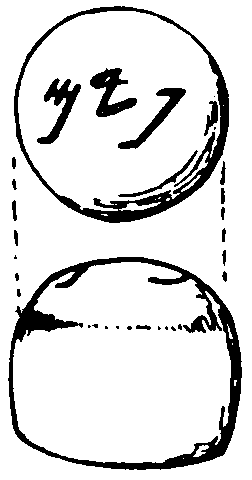Pim weight
Pim weights were polished stones about 15 mm (5/8 inch) diameter, equal to about two-thirds of a Hebrew shekel. Many specimens have been found since their initial discovery early in the 20th century, and each one weighs about 7.6 grams, compared to 11.5 grams of a shekel. Its name, which can also be transliterated as "payim", comes from the inscription seen across the top of its dome shape: the Phoenician letters 𐤐𐤉𐤌 (Hebrew פים, transliterated pym).

Impact
Prior to the discovery of the weights by archaeologists, scholars did not know how to translate the word pim (פִ֗ים p̄îm) in 1 Samuel 13:21.[1] Robert Alexander Stewart Macalister's excavations at Gezer (1902-1905 and 1907-1909) were published in 1912 with an illustration showing one such weight, which Macalister compared to another published in 1907 by Charles Simon Clermont-Ganneau.[2][3]
Here is the 1611 translation of the King James Version of the Bible:
- Yet they had a file for the mattocks, and for the coulters, and for the forks, and for the axes, and to sharpen the goads.
The 1982 New King James Version rendered it:
- And the charge for a sharpening was a pim for the plowshares, the mattocks, the forks, and the axes, and to set the points of the goads.
Photos
 Top-view of an unprovenanced pim weight |  Side-view of an unprovenanced pim weight |
See also
- Ancient Hebrew units of measurement
- Biblical archaeology
- List of artifacts significant to the Bible
References
- William G. Dever, Will Dever. Recent Archaeological Discoveries and Biblical Research. Samuel and Althea Stroum lectures in Jewish studies. Publisher: University of Washington Press, 1989. p 33. ISBN 0295972610, 9780295972619
- R. A. Stewart Macalister (1912) The Excavation of Gezer: 1902-1905 and 1907-1909, Volume II, p. 285, 292.
- Charles Simon Clermont-Ganneau (1885), Recueil d'archéologie orientale, Volume VIII, section 14. An incomplete version is available online, which does not include the section in which Macalister says the work on the pim weights is found.
Sources
- Macalister, R. A. Stewart (1912). The Excavation of Gezer 1902-1905 and 1907-1909 Vol. II. London: John Murray. p. 285.
- Avraham Negev; Shimon Gibson, eds. (2003). Archaeological Encyclopedia of the Holy Land. New York: The Continuum International Publishing Group Inc. pp. 537–9.